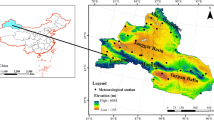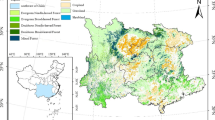Abstract
The alpine wetlands in QTP (Qinghai-Tibetan Plateau) have been profoundly impacted along with global climate changes. We employ satellite datasets and climate data to explore the relationships between alpine wetlands and climate changes based on remote sensing data. Results show that: 1) the wetland NDVI (Normalized Difference Vegetation Index) and GPP (Gross Primary Production) were more sensitive to air temperature than to precipitation rate. The wetland ET (evapotranspiration) across alpine wetlands was greatly correlated with precipitation rate. 2) Alpine wetlands responses to climate changes varied spatially and temporally due to different geographic environments, variety of wetland formation and human disturbances. 3) The vegetation responses of the Zoige wetland was the most noticeable and related to the temperature, while the GPP and NDVI of the Qiangtang Plateau and Gyaring-Ngoring Lake were significantly correlated with both temperature and precipitation. 4) ET in the Zoige wetland showed a significantly positive trend, while ET in Maidika wetland and the Qiangtang plateau showed a negative trend, implying wetland degradation in those two wetland regions. The complexities of the impacts of climate changes on alpine wetlands indicate the necessity of further study to understand and conserve alpine wetland ecosystems.
Similar content being viewed by others
References
An S, Zhu X, Shen M et al., 2018. Mismatch in elevational shifts between satellite observed vegetation greenness and temperature isolines during 2000–2016 on the Tibetan Plateau. Global Change Biology, 24(11): 5411–5425. doi: 10.1111/gcb.14432
Bai J H, Lu Q Q, Wang J J et al., 2013. Landscape pattern evolution processes of alpine wetlands and their driving factors in the Zoige Plateau of China. Journal of Mountain Science, 10(1): 54–67. doi: 10.1007/s11629-013-2572-1
Cui M M, Ma A Z, Qi H Y et al., 2015. Warmer temperature accelerates methane emissions from the Zoige wetland on the Tibetan Plateau without changing methanogen community composition. Scientific Reports, 5: 11616. doi: 10.1038/srep11616
Gao Junqin, Ouyang Hua, Lei Guangchun et al., 2011. Effects of temperature, soil moisture, soil type and their interactions on soil carbon mineralization in Zoigê alpine wetland, Qinghai- Tibet Plateau. Chinese Geographical Science, 21(1): 27–35. doi: 10.1007/s11769-011-0439-3
Gao Q Z, Guo Y Q, Xu H M et al., 2016. Climate change and its impacts on vegetation distribution and net primary productivity of the alpine ecosystem in the Qinghai-Tibetan Plateau. Science of The Total Environment, 554–555: 34–41. doi: 10.1016/j.scitotenv.2016.02.131
He Jie, Yang Kun, 2011. China Meteorological Forcing Dataset. Cold and Arid Regions Science Data Center at Lanzhou, China. (in Chinese)
Hu S J, Niu Z G, Chen Y F et al., 2017. Global wetlands: potential distribution, wetland loss, and status. Science of The Total Environment, 586: 319–327. doi: 10.1016/j.scitotenv.2017.02.001
Huang C Q, Peng Y, Lang M et al., 2014. Wetland inundation mapping and change monitoring using Landsat and airborne LiDAR data. Remote Sensing of Environment, 141: 231–242. doi: 10.1016/j.rse.2013.10.020
Huang X D, Deng J, Wang W et al., 2017. Impact of climate and elevation on snow cover using integrated remote sensing snow products in Tibetan Plateau. Remote Sensing of Environment, 190: 274–288. doi: 10.1016/j.rse.2016.12.028
Ijmker J, Stauch G, Pötsch S et al., 2012. Dry periods on the NE Tibetan Plateau during the late Quaternary. Palaeogeography, Palaeoclimatology, Palaeoecology, 346–347: 108–119. doi: 10.1016/j.palaeo.2012.06.005
Kang X M, Hao Y B, Cui X Y et al., 2016. Variability and changes in climate, phenology, and gross primary production of an alpine wetland ecosystem. Remote Sensing, 8(5): 391. doi: 10.3390/rs8050391
Li B Q, Zhang J Y, Yu Z B et al., 2017. Climate change driven water budget dynamics of a Tibetan inland lake. Global Planet Change, 150: 70–80. doi: 10.1016/j.gloplacha.2017.02.003
Li J, Shi W, 2015. Effects of alpine swamp wetland change on rainfall season runoff and flood characteristics in the headwater area of the Yangtze River. Catena, 127: 116–123. doi: 10.1016/j.catena.2014.12.020
Liu Dong, Wang Tao, Shen Weishou et al., 2016. Dynamic of the alpine wetlands and its response to climate change in the Yarlung Zangbo River Valley in recent 30 years. Journal of Ecology and Rural Environment, 32(2): 243–251. (in Chinese)
Lu Chunxia, Xie Gaodi, Xiao Yu et al., 2004. Ecosystem diversity and economic valuation of Qinghai-Tibet Plateau. Acta Ecologica Sinica, 24(12): 2749–2755. (in Chinese)
Mao D H, Wang Z M, Wu J G et al., 2018. China’s wetlands loss to urban expansion. Land Degradation & Development, 29: 2644–2657.
Niu Z G, Gong P, 2018. Large-scale wetland mapping and evaluation. Comprehensive Remote Sensing, 6: 45–77. doi: 10.1016/B978-0-12-409548-9.10381-1
Niu Z G, Zhang H Y, Wang X W et al., 2012. Mapping wetland changes in China between 1978 and 2008. Chinese Science Bulletin, 57(22): 2813–2823. doi: 10.1007/s11434-012-5093-3
Shen M G, Piao S L, Jeong S J et al., 2015a. Evaporative cooling over the Tibetan Plateau induced by vegetation growth. Proceedings of the National Academy of Sciences of the United States of America, 112(30): 9299–9304. doi: 10.1073/pnas.1504418112
Shen W S, Zou C X, Liu D et al., 2015b. Climate-forced ecological changes over the Tibetan Plateau. Cold Regions Science and Technology, 114: 27–35. doi: 10.1016/j.coldregions.2015.02.011
Song Yi, Ma Mingguo, 2007. Study on vegetation cover change in Northwest China based on SPOT VEGETATION data. Journal of Desert Research, 27(1): 89–93, 173. (in Chinese)
Wang C Z, 2016. A remote sensing perspective of alpine grasslands on the Tibetan Plateau: Better or worse under ‘Tibet Warming’? Remote Sensing Applications Society and Environment, 3: 36–44. doi: 10.1016/j.rsase.2015.12.002
Wang Genxu, Li Yuanshou, Wang Yibo et al., 2007. Typical alpine wetland system changes on the Qinghai-Tibet Plateau in recent 40 years. Acta Geographica Sinica, 62(5): 481–491. (in Chinese)
Wu G L, Ren G H, Wang D et al., 2013. Above- and below- ground response to soil water change in an alpine wetland ecosystem on the Qinghai-Tibetan Plateau, China. Journal of Hydrology, 476(4): 120–127. doi:10.1016/j.jhydrol.2012.10.031
Xue J Y, Zhang H X, He N P et al., 2015. Responses of SOM decomposition to changing temperature in Zoige alpine wetland, China. Wetlands Ecology and Management, 23(5): 977–987. doi: 10.1007/s11273-015-9434-2
Xue Z S, Zhang Z S, Lu Xianguo et al., 2014. Predicted areas of potential distributions of alpine wetlands under different scenarios in the Qinghai-Tibetan Plateau, China. Global and Planetary Change, 123: 77–85. doi: 10.1016/j.gloplacha.2014.10.012
Yang K, Wu H, Qin J et al., 2014. Recent climate changes over the Tibetan Plateau and their impacts on energy and water cycle: A review. Global and Planetary Change, 112(1): 79–91. doi: 10.1016/j.gloplacha.2013.12.001
Yang Qin, Cui Caixia, 2005. Impact of climate change on the surface water in Bayanbuluk Alpine-cold wetland in the Tianshan mountainous. Journal of Glaciology and Geocryology, 27(3): 397–403. (in Chinese)
Yao Huiru, Li Dongliang, 2016. The interannual variation of wind speed in the Tibetan Plateau in spring and its response to global warming during 1971–2012. Acta Meteorologica Sinica, 74(1): 60–75. (in Chinese)
You Q L, Kang S C, Aguilar E et al., 2008. Changes in daily climate extremes in the eastern and central Tibetan Plateau during 1961–2005. Journal of Geophysical Research Atmospheres, 113(D7): D07101. doi: 10.1029/2007jd009389
Yu Pingping, 2016. The current situation and countermeasures of environmental protection in Maidika Wetland in Tibet. Agricultural Technical Services, 33(1): 198–203. (in Chinese)
Yuan Y L, Si G C, Wang J et al, 2014. Bacterial community in alpine grasslands along an altitudinal gradient on the Tibetan Plateau. Fems Microbiology Ecology, 87(1): 121–132. doi: 10.1111/1574-6941.12197
Zhang Bo, Qin Qiming, Sun Yongjun et al., 2010. Dynamic monitoring and change analysis of Gyaring Lake and Ngoring Lake of recent 30 years based on remote sensing method. Science of Surveying and Mapping, 35(04): 54–56. (in Chinese)
Zhang Shunyao, Zhang Fugui, Yang Zhibin et al., 2017. The research on the effect of gas hydrate exploration on wetland carbon cycle in the Tibetan Plateau. Geophysical and Geochemical Exploration, 41(6): 1044–1049. (in Chinese)
Zhang W J, Yi Y H, Song K C et al., 2016. Hydrological response of alpine wetlands to climate warming in the eastern Tibetan Plateau. Remote Sensing, 8(4): 336. doi: 10.3390/rs8040336
Zhang Y, Wang G X, Wang Y B, 2011. Changes in alpine wetland ecosystems of the Qinghai-Tibetan plateau from 1967 to 2004. Environmental Monitoring and Assessment, 180(1–4): 189–199. doi: 10.1007/s10661-010-1781-0
Zhang Z X, Chang J, Xu C Y et al., 2018. The response of lake area and vegetation cover variations to climate change over the Qinghai-Tibetan Plateau during the past 30years. Science of The Total Environment, 635: 443–451. doi: 10.1016/j.scitotenv.2018.04.113
Zhao Zhilong, Zhang Yili, Liu Linshan et al., 2014. Advances in research on wetlands of the Tibetan Plateau. Progress in Geography, 33(9): 1218–1230. (in Chinese)
Zhu W Q, Jiang N, Chen G S et al., 2017. Divergent shifts and responses of plant autumn phenology to climate change on the Qinghai-Tibetan Plateau. Agricultural and Forest Meteorology, 239: 166–175. doi: 10.1016/j.agrformet.2017.03.013
Acknowledgements
Climate data used in this study were developed by Cold and Arid Regions Science Data Center at Lanzhou (http://westdc.westgis.ac.cn/data). The NDVI data for MOD13 from 2000 to 2015 were obtained from the NASA Surface Process Data Center (https://e4ftl01.cr.usgs.gov) and MOD16 evapotranspiration data and the MOD17 photosynthetic productivity data come from the NTSG (http://www.ntsg.umt.edu/project).
Author information
Authors and Affiliations
Corresponding author
Additional information
Foundation item: Under the auspices of the National Key R & D Program of China (No. 2017YFA0603004), Strategic Priority Research Program of Chinese Academy of Sciences (No. XDA19030203), National Natural Science Foundation of China (No. 41971390)
Rights and permissions
About this article
Cite this article
Wang, R., He, M. & Niu, Z. Responses of Alpine Wetlands to Climate Changes on the Qinghai-Tibetan Plateau Based on Remote Sensing. Chin. Geogr. Sci. 30, 189–201 (2020). https://doi.org/10.1007/s11769-020-1107-2
Received:
Accepted:
Published:
Issue Date:
DOI: https://doi.org/10.1007/s11769-020-1107-2




